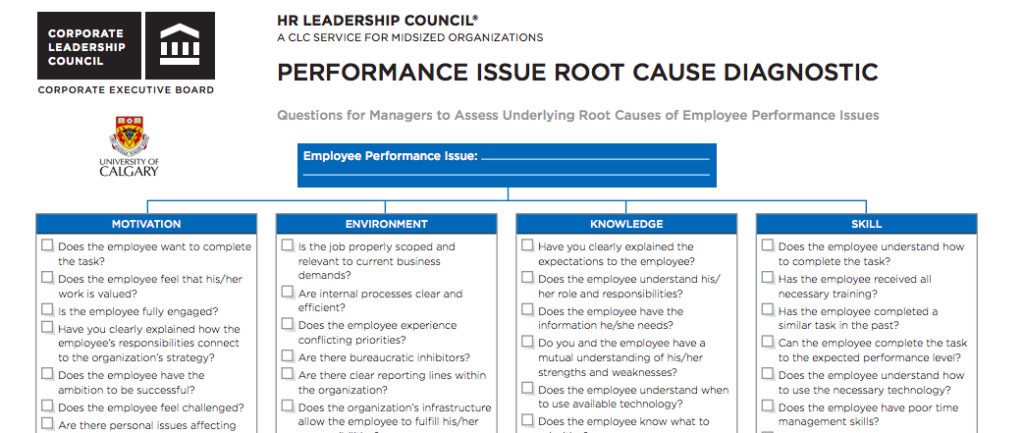
An underperforming employee can drag the entire team down and create unnecessary drama and tension. It could be things such as missing deadlines, not thinking strategically, poor communication, missing goals, or many other things. The “knee jerk” reaction for many managers, after most likely several intense conversations and a lot of frustration, is training or termination.
That might still be the end result, but there is a better three-step process to go through that I outline below.
Here’s an important data point to keep in mind when you are thinking about this: A manager’s ability to accurately and quickly diagnose their employees’ performance challenges and then provide the right prescriptive solutions is critical to building high-performing teams and companies.
If a manager can’t, it not only causes frustration between the manager and employee, it cascades through the entire team and other teams they interact with.
Managers often struggle to understand the root causes when employees struggle. How? They often assume that the “surface level” issue is the problem when it actually runs much deeper. Often times there is/are issue(s) beyond knowledge, skill, and competency that play a primary or secondary role.
If you don’t address the entirety of the challenge, it often comes back again in a different scenario. That’s both costly and huge time waste.
The first place to start is root cause analysis (i.e. getting to the “roots” of what’s causing the issue and why they can’t move past it). These are self-reflective questions the manager can run through, then discuss with the employee and finally implement.
Before you go through root cause analysis it’s worthwhile to run through a quick exercise: There are three key questions that help determine if someone can change, overcome an obstacle/difficulty and learn skills/knowledge to get to the next level in their career.
- Are they willing? (You can’t do much with someone who isn’t.)
- Are they motivated and do they care? (If they are disconnected, and disengaged, it’s really, really hard to help someone).
- Are they coachable? (Change requires new behaviors, thinking, and actions. If they aren’t open to new ideas and taking new “leaps of faith” to trying new things, you can’t move them forward).
Unless you are very certain the answer is “no” for all three, keep reading. There is hope and a possibility for improvement. And remember, every great employee at one point in their career will get really stuck.
Here’s the three-step employee performance root cause analysis process
Step 1: Diagnose the Problem
Answer the following questions…
- What are they required to do?
- Who do they have to work with?
- When and where do their underperformance issues appear?
- What’s the impact of the underperformance?
- What does great, average and poor performance look like? (and do they know what it looks like?)
- What has been done in the past to address it?
Step 2: Do Root Cause Analysis (see the template/tool kit below)
There is a useful performance issue diagnostic tool that can help a manager get at the potential root causes for the employee’s underperformance. Check it out. It goes through a template and check-list on their motivation, knowledge, skill, and environment.
Here is part of it so you can see it before you download it (sorry for the small size):

There are a few key questions that I would add to the above list:
- Do they understand how they will be evaluated?
- How are they being measured? Tasks, activities and/or results?
- Are they regularly informed about the feedback? Is it soon and often enough? Is it specific and accurate? Is it understandable and clear to them? Is it tied to things under their control?
- Are there incentives for them do well? Do they know what they are? Are they motivating for them?
Step 3: Prescribe the Right Solution
Sometimes it’s not just the employee that needs help, it’s the manager too.
- If it’s knowledge/skills – provide education, training, and coaching
- If it’s standards/measures – realign expectations and provide “crystal clarity” on measurements
- If it’s lack of feedback – the manager needs to get leadership and management coaching
- If it’s environmental – provide the additional resources, tools, assistance and anything else they need.
- If it’s ability – rehire if the skills, knowledge, and experience gap is too big.
Root cause analysis is very helpful when looking at employee performance challenges. It also can be very useful for high-performing employees to get them even more engaged and motivated.
PS: Get the #1 teamwork, team-building and employee experience game and program that more than 25,000+ leaders, managers, and employees are using to skyrocket communication, collaboration, trust, and performance. It’s based on research where complete strangers built the closest relationships in their life in 45 minutes. Many leading companies are using it such as Amazon, Southwest Airlines, Ernst & Young, Google, Gillette, Microsoft, Oracle, Blue Cross Blue Shield, Worldwide Express, CareHere, Oklahoma City Thunder (NBA team), Houghton Mifflin Harcourt, Novartis, Merck, Intel, Thermo Fisher Scientific, Bank of America, Goldman Sachs and many others.

